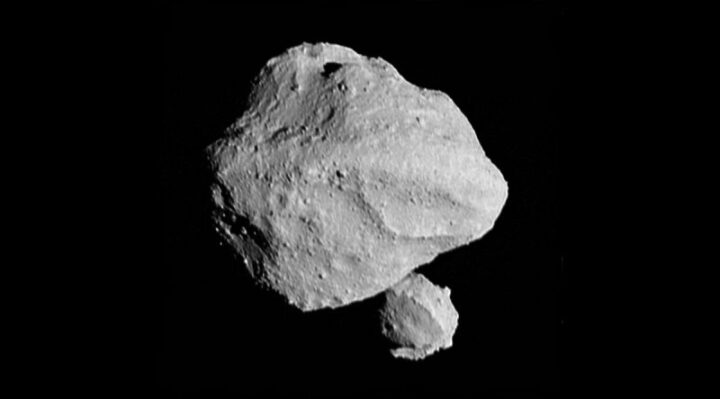
Researchers learned that the asteroid known as “Dinky” was not alone in orbit when NASA’s Lucy mission passed by its first confirmed target, Dinkinesh, in November 2023. “Selam,” as the scientists called the satellite asteroid, was in orbit around Dinky. As Lucy continued to transmit data back to Earth, the scientists made an unexpected discovery: Selam was actually a contact binary, or two moons fused into one.
Jessica Sunshine, a professor of astronomy and geology at the University of Maryland, is part of the Lucy team. They reported the surprising discovery in a study that was published in the journal Nature on May 29, 2024.
The peculiar configuration, according to the researchers, casts doubt on accepted notions about how asteroids and other celestial bodies originated over geological time and sheds more light on the dynamics, internal structure, and evolutionary background of both Dinky and Selam.
Sunshine, one of the paper’s co-authors, stated, “There’s a lot more complexity in these small bodies than we originally thought.” “With the additional observations taken by the spacecraft, we were able to better analyze features such as Dinkinesh’s rotation speed and Selam’s orbit pattern. We also have a better understanding of what materials they’re possibly made of, bringing us a step closer to learning just how terrestrial bodies are created.”
Images obtained by the Lucy spacecraft showed the contact binary currently known as Selam (named after the juvenile counterpart of the Lucy hominin fossil discovered in 1974), a ridge that formed after the asteroid’s structural failure, and a trough on Dinkinesh where about a quarter of the asteroid broke off from its main body.
The scientists proposed that Dinky shed and ejected rocky debris into orbit as a result of its rapid rotating motion, which was enhanced by the asteroid’s uneven surface reflection of sunlight. Part of the material may have showered back down on Dinky as rocks, creating the ridges that the Lucy probe observed, and some may have collected to form Selam.
The lead scientist for the Lucy mission, Hal Levison of the Southwest Research Institute in Boulder, Colorado, stated, “One of the things that’s critical to understanding how planets like Earth got here is understanding how objects behave when they hit each other, and to understand that we need to understand their strength.”
“Basically, the planets formed when [smaller objects like asteroids] orbiting the sun ran into each other. Whether objects break apart when they hit or stick together has a lot to do with their strength and internal structure.”
The group concluded that Dinky was probably able to retain most of its form because it possessed some internal strength.
Although it’s still unclear how Dinky’s peculiar dual moons developed, Sunshine stated that the team’s discoveries allow for comparison research with other celestial bodies that are similar to Dinky.
“I’m personally very excited to compare the Didymos binary system with this one, especially as they appear to share many similarities such as size, general shape and possibly composition despite being in totally different parts of the solar system,” Sunshine said. Sunshine was also part of the NASA DART research team and provided information about how the DART spacecraft was able to deflect Dimorphos, a small moon of Didymos.
“The Didymos binary system is located in a near-Earth environment while the Dinkinesh system is located much farther away from Earth in the main asteroid belt,” she stated. “They have very different features but we think they may have undergone similar processes to become what we know of them today.”
Over the course of its 12-year voyage, Lucy intends to examine 11 asteroids, the first two of which are Dinkinesh and its satellite. In December 2024, after circling the inner rim of the main asteroid belt, Lucy returns to Earth in need of assistance from gravity. The spacecraft will be propelled back through the main asteroid belt after that near flyby, where it will observe Donaldjohanson in April 2025 and the Trojan asteroids in 2027.
“Our ultimate goal is to understand the formation of celestial bodies,” Sunshine stated. “How do planets form? How was Earth formed? We know that big planets are formed by smaller bodies, so studying these little asteroids lets us see how materials behave and interact on a smaller scale. With Dinky and the other asteroids we’re flying by, we’re laying the groundwork for understanding how planets are made.”



